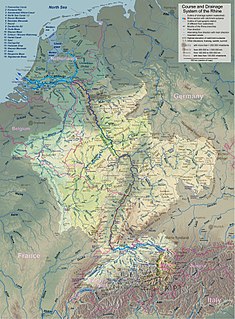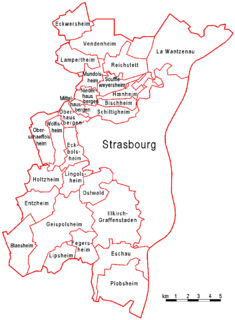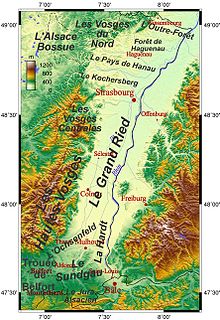Hausbergen is a natural region and historic territory in Alsace now divided between three communes of Greater Strasbourg intercommunal structure:

Alsace is a cultural and historical region in eastern France, on the west bank of the upper Rhine next to Germany and Switzerland.
The commune is a level of administrative division in the French Republic. French communes are analogous to civil townships and incorporated municipalities in the United States and Canada, Gemeinden in Germany, comuni in Italy or ayuntamiento in Spain. The United Kingdom has no exact equivalent, as communes resemble districts in urban areas, but are closer to parishes in rural areas where districts are much larger. Communes are based on historical geographic communities or villages and are vested with significant powers to manage the populations and land of the geographic area covered. The communes are the fourth-level administrative divisions of France.
- Niederhausbergen (lower Hausbergen)
- Mittelhausbergen (middle or central Hausbergen)
- Oberhausbergen (upper Hausbergen). [1] [2]

Niederhausbergen is a commune in the Bas-Rhin department in Grand Est in north-eastern France.

Mittelhausbergen is a commune in the Bas-Rhin department in Grand Est in north-eastern France.

Oberhausbergen is a commune in the Bas-Rhin department in Grand Est in north-eastern France.
It was the site of the Battle of Hausbergen in 1262, after which Strasbourg became a Free imperial city.

The Battle of Hausbergen took place on 8 March 1262 and marks the freeing of the city of Strasbourg from episcopal authority. The bourgeois of the town defeated the army of knights of the Bishop of Strasbourg, Walter of Geroldseck.

In the Holy Roman Empire, the collective term free and imperial cities, briefly worded free imperial city, was used from the fifteenth century to denote a self-ruling city that had a certain amount of autonomy and was represented in the Imperial Diet. An imperial city held the status of Imperial immediacy, and as such, was subordinate only to the Holy Roman Emperor, as opposed to a territorial city or town which was subordinate to a territorial prince – be it an ecclesiastical lord or a secular prince.
The Hausbergen hills, overlooking the Rhine valley on the east and touching the Kochersberg hills in the west, are located on the territories of the three villages and extend to Mundolsheim. [3] [4] [5] Their peaks culminate at 186 m (610 ft) (Holderberg), 184 m (604 ft) (Pfaffenberg) and 181 m (594 ft) (Alterberg). [6]

A hill is a landform that extends above the surrounding terrain. It often has a distinct summit, although in areas with scarp/dip topography a hill may refer to a particular section of flat terrain without a massive summit.

The Rhine is one of the major European rivers, which has its sources in Switzerland and flows in an mostly northerly direction through Germany and The Netherlands to the North Sea. The river begins in the Swiss canton of Graubünden in the southeastern Swiss Alps, forms part of the Swiss-Liechtenstein, Swiss-Austrian, Swiss-German and then the Franco-German border, then flows through the German Rhineland and the Netherlands and eventually empties into the North Sea.

The Kochersberg is a natural region of the French département of Bas-Rhin in Alsace and is a part of the hills found along the eastern side of the Vosges mountains. It gave its name to the Communauté de communes du Kochersberg, a cooperation of 23 municipalities.














